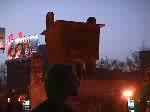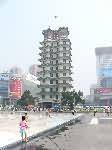- Getting around Lijiang. Dont stay in the Old Towns more than 2 days, there is nothing to do. KRISS Oct 9, 2013 05:46
- 2013 Beijing Temple Fair BENNYLAU Feb 26, 2013 03:29
- Malaysian traveling from KUL - LAX vis Shanghai PVG ZATI_DY Jan 3, 2013 20:15
The New Face of Zhengzhou
- Views: 10040
- |Vote: 4 1
- |Add to Favorites
- |Recommend to Friends
Long Ago in Zhengzhou
What happened to the old Zhengzhou? When did this little provincial capital shed its tired husk and begin to glisten with this new and decorous style? Where did this sharp new look of central Zhengzhou come from? Walking through Erqi Square in the early morning, watching the crowds flow across the new glass overpasses and the children streak through the massive open fountain, the jets of water shooting up right in the middle of the pedestrian courtyard, I could hardly recognise the city I'd visited five years before. If not for the distinctive twin needle shape of the Erqi tower, I'd have assumed I was in another place entirely.
Despite being the capital of Henan province, most people tend to pass it by on their way to more celebrated destinations in the area, the most noteworthy of which being the now world-famous Shaolin temple, which now hosts popular martial arts lessons for foreigners who can choose to live and study with the monks for long or short periods of time. The first time I visited Zhengzhou was unintentional – I was headed for Xi'an and couldn't get a ticket, so I decided instead to go most of the way there and stop off in Zhengzhou.
My impressions of Zhengzhou at that time were typical of most travellers' towards many places in Henan – walking out from the train station into the crowds of countrysiders roaming the great square, the city seemed a populous mess. Even the swept up roads seemed untidy somehow, and the sun cast a dreary light over old buildings and the stained tiles inexpertly plastered on the walls of run-down hotels.
The locals scared me then. I walked for a couple of hours through the back streets on the way to a little park on the corner of Shangcheng Lu and Renmin Lu. I passed the vague stares of uncurious strangers whose minds seemed to be spinning in slow, erratic rings. An old man with large, Fu Manchu style moon-circle sunglasses and a long, wispy beard nodded as I passed, and the chubby, red-faced woman with short, scraggy hair behind her counter of sweaty, fatty lumps of meat looked past me, frightened, her large blunt cleaver, sticky with animal grease, limp and grotesque in her uncertain grasp. Cyclists passed noiselessly in the dim light, and when I reached the park, a lone youth sat with head suspended just above his knees, muttering into his lap, swaying like blown grass.
The park itself was worth seeing, with its attractive landscaping and giant 'ding' (ancient Chinese urn) monument to the Shang dynasty. Zhengzhou's heyday was way back then, 3500 years ago when Chinese civilization was concentrated in Henan. The 'ding' itself was made of metal with three or four stumpy legs, and was literally a measure of aristocracy – the higher your social position, the more 'dings' you would have in your house. In modern Chinese, this history is preserved in a proverb, where a rich person's home is sometimes described as having many 'dings' and bells, the musical instrument common to the age.
I enjoyed the park, but still couldn't help but be disturbed at the local inhabitants, many of whom seemed to have come to wander aimlessly and look nowhere. In a pagoda at the back of the park, two lovers seemed to be meeting for the last time, the man beating his head with his own hands and the girl staring guiltily at her thighs. Only one old man had the beatific look of someone satisfied with his existence, writing poetry with a large water brush onto the marble tiles. I watched his calligraphy with admiration and a little envy. The characters he'd painted earlier were already evaporating in the evening swelter.
Renewed Zhengzhou
That was five years ago, and this time in Zhengzhou, my impressions couldn't be more different. The railway station area still looked the same, but the people in the square were busy and the atmosphere was entrepreneuring as the crowds rushed past each other purposefully. I walked the short distance to the square, stopping briefly for a cheap and filling street snack, and was astounded when I arrived to see the changes in Erqi Square and the new look. Where the fountain was before had been dirty cracked pavement, the overpasses replaced older concrete bridges, and the new malls transformed the area into something of International class.
I'd decided to come and visit the major Zhengzhou attractions I'd missed before in my rushed and uncomfortable earlier visit, the first of which being the opportunity to climb the tower.
The 63 metre high, 14 floor tower is built to commemorate the 1923 worker's action against the railroad authority whose unfair work conditions and poor pay were cruel and insufferable. The action turned violent and resulted in the death of some revolutionary heroes, but the event is honoured by the tower, constructed in the socialist spirit of revolutionary ideology right in the middle of the cultural revolution. It was originally called the 'Zhengzhou Erqi Revolutionary Memorial Museum' (Erqi meaning 2-7, as the 1923 revolution was staged on February the seventh), but after the revolutionary spirit cooled off somewhat in the late Seventies, then Party Secretary Zhang Zemin renamed the tower 'Zhengzhou Erqi Memorial Museum'.
It's certainly a monument steeped in the old revolutionary spirit still. The tower is topped by a 2.7 metre bell and clock, but on the turning of the hour the bell resounds not with the usual melody, but with the revolutionary anthem 'The East is Red'. I listened to the somewhat wandering tune as the gates opened at nine, and made my way up the staircase – the lift to the top being out of service.
On each level is an exhibit of paintings, sketches, and rousing stories of fallen heroes and their somber photographs. I was in the mood to be cynical, but had to admit that the stories were moving and some even quite powerful – these were poor workers with high ideals who were fighting for fair treatment for all, and who were slaughtered at the hands of their own government, the Kuomingtang, for resisting what amounted to forced labour.
The view from the top gives a clear skyline of Zhengzhou city, and it confirmed my impressions of development I'd witnessed in the square below. New towers were going up all over the city, and I could see quiet roads with lines of green trees, and most of all, a multitude of people, many well-dressed and probably well-off, circulating busily below.
I made my way back down and proceeded to my next destination, the Shang Dynasty city wall. I'd read that this was one of the oldest existing walls in China, a simple defensive barrier constructed three and a half thousand years before, making it older than the Great Wall itself. I found that many of the busses headed West from the tower passed the wall, and that it was actually just close enough to walk on a day when the weather is forgiving – but as that particular day was unbearably hot, I took public transport.
A tourist who has been to Xi'an or the Great Wall might be disappointed by Zhengzhou's effort. Xi'an's city wall in particular is strongly constructed in great slabs of marble brick in traditional Eastern style, and the Great Wall at such places as Badaling stretches majestically over the mountain peaks in symmetrical castellated rows. The Zhengzhou Shang Dynasty wall, by comparison, is an unsightly ripple of clay that looks more of a long mound of earth than it does a wall. Little has been done to restore the wall since it was excavated; the packed earth has been tidied a little, trees grow on the top and from the sides, and a pathway along its rim is worn in by the passage of the locals who use the wall as a shortcut between the main roads.
I got over the disappointment easily, however. The wall's old – extremely old – and I appreciated the fact that it had been left more or less in the condition in which it was found. There are other places in China where historical objects have been altered entirely – Badaling being a good example, where the Great Wall has been almost completely rebuilt. Dandong's Great Wall is a mere estimation, built within the last ten years and based on written records of a Northeastern wall, without any foundation on ruins at all. Zhengzhou's wall is genuine and quite austere. It runs a good length around the West and South of the old city center, and is a very pleasant walk at an elevation that lends nice views over Zhengzhou suburbs. I stopped at the Southern end in a courtyard where old folks were out playing traditional music on a two-stringed violin and singing operatic melodies, and was quite satisfied with the morning.
Zhengzhou has become, I decided, a city well deserving of an extended visit. Whilst it is possible to pass through and check out a few of the attractions in the central city, allowing a vivid enough impression of the place, Zhengzhou has many other sites of historical and cultural importance owing to its location at the origin of central Chinese culture. There are so many artifacts under the ground that some of the exhibits in the Zhengzhou museum were unearthed when digging the foundations for the museum itself. Zhengzhou is old, but the renovations of recent years have taken away something of its disturbing, senile atmosphere, and brought something of a fresh life to the city.





 Copyright © 1998-2025 All rights reserved.
Copyright © 1998-2025 All rights reserved.
1.
Sep 12, 2005 12:06 Reply
MISHEN said:
Luobo qingcai, ge you suo ai!
2.
Sep 12, 2005 11:24 Reply
DOUTIN said:
Sorry all,
I visited Zhengzhou and didn't not like it at all. It's the worst place in ALL Henan: crowded, dirty, and if not..dangerous...
Be EXTREMELY careful!"""
3.
Aug 4, 2005 00:38 Reply
MISHEN said:
I'm a New Zealander living in China - I'm glad you like Zhengzhou, I think it's a great place!
4.
Aug 3, 2005 22:17 Reply
PLUIEPOCO said:
Wow... You're quite insightful. I studied in Zhengzhou University for 4 years and worked there for 1 year. Zhengzhou is like somewhat my second home, you quoted some places that are too familiar to me. And your writings are moving, your wording artistic, I guess, and dare to ask you, are you British?
And @Katherline, your are nice in your picture.:)
5.
Aug 2, 2005 10:26 Reply
CATHERINE said:
Yes, indeed, I always passed by the city on the train, but never paid a visit to the city.